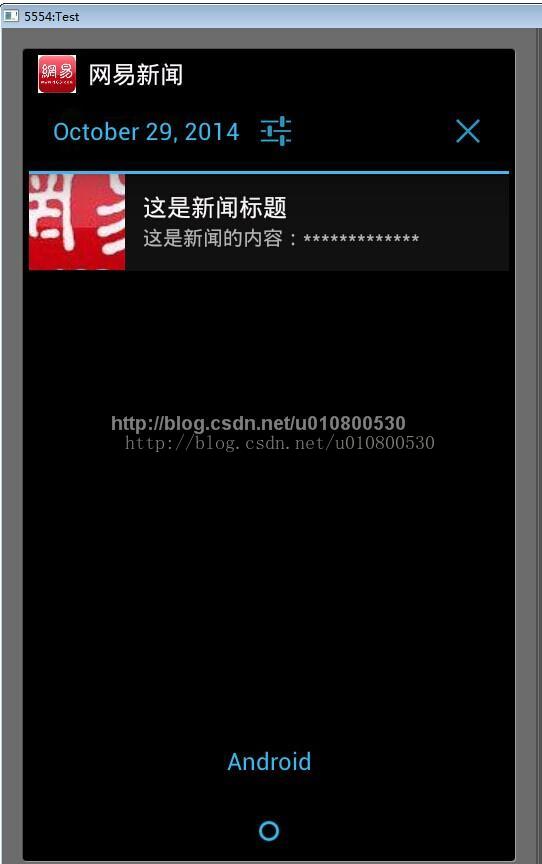Android开发系列(二十四):Notification的功能与用法
来源:程序员人生 发布时间:2014-11-20 08:57:45 阅读次数:3232次
关于消息的提示有两种:1种是Toast,1种就是Notification。前者保持的时间比较短暂,后者保持的时间比较长。
而且我们平常手机的利用比如网易、贴吧等等都有很多的推送消息,就是用Notification实现的。
Notification是显示在手机状态栏的通知―手机状态栏位于手机屏幕的上方。程序1般通过NotificationManager服务来发送Notification通知
Notification的1些方法,接下来我们都能够用到:
setDefaults():设置通知LED等、音乐、震动等等。
setAutoCancel():设置点击通知后,状态栏自动删除通知。
setContentTitle():设置通知的标题
setContentText():设置通知的内容
setTicker():设置通知的提示信息
setSmallIcon():为通知设置图标(注意这个方法第3个是i的大写,不是L的小写)
发送Notification的步骤:
1、调用getSystemService(NOTIFICATION_SERVICE)方法获得系统的Notification Manager服务
2、通过构造器创建1个Notification对象。
3、为Notification设置各种属性。
4、通过NotificationManager发送Notification。
在这里,我们要注意1点要在AndroidManifest.xml文件中添加几个权限:
<!-- 添加操作闪光灯的权限 -->
<uses-permission android:name="android.permission.FLASHLIGHT" />
<!-- 添加操作振动器的权限 -->
<uses-permission android:name="android.permission.VIBRATE" />
接下来,我们通过具体的代码来讲明。
main.xml:
<span style="font-size:14px;"><?xml version="1.0" encoding="utf⑻"?>
<LinearLayout xmlns:android="http://schemas.android.com/apk/res/android"
android:orientation="horizontal"
android:layout_width="fill_parent"
android:layout_height="fill_parent"
android:gravity="center_horizontal"
>
<Button
android:layout_width="wrap_content"
android:layout_height="wrap_content"
android:text="发送Notification"
android:onClick="send"
/>
</LinearLayout>
</span>
这里设置了1个按钮,点击会发送通知
然后,我们看下NotificationTest.java的代码:
<span style="font-size:14px;">package cn.notificationtest.com;
import cn.notificationtest.com.R;
import android.app.Activity;
import android.app.Notification;
import android.app.NotificationManager;
import android.app.PendingIntent;
import android.content.Intent;
import android.net.Uri;
import android.os.Bundle;
import android.view.View;
public class NotificationTest extends Activity
{
static final int NOTIFICATION_ID = 0x123;
NotificationManager nm;
@Override
public void onCreate(Bundle savedInstanceState)
{
super.onCreate(savedInstanceState);
setContentView(R.layout.main);
// 获得系统的NotificationManager服务
nm = (NotificationManager)
getSystemService(NOTIFICATION_SERVICE);
}
// 为发送通知的按钮的点击事件定义事件处理方法
public void send(View source)
{
// 创建1个启动其他Activity的Intent
Intent intent = new Intent(NotificationTest.this
, OtherActivity.class);
PendingIntent pi = PendingIntent.getActivity(
NotificationTest.this, 0, intent, 0);
Notification notify = new Notification.Builder(this)
// 设置打开该通知,该通知自动消失
.setAutoCancel(true)
// 设置显示在状态栏的通知提示信息
.setTicker("网易新闻")
// 设置通知的图标
.setSmallIcon(R.drawable.notify)
// 设置通知内容的标题
.setContentTitle("这是新闻标题")
// 设置通知内容
.setContentText("这是新闻的内容:*************")
// // 设置使用系统默许的声音、默许LED灯
// .setDefaults(Notification.DEFAULT_SOUND
// |Notification.DEFAULT_LIGHTS)
// 设置通知的自定义声音
.setSound(Uri.parse("android.resource://cn.notificationtest.com/"+R.raw.msg))
.setWhen(System.currentTimeMillis())
// 设改通知将要启动程序的Intent
.setContentIntent(pi).getNotification();
// 发送通知
nm.notify(NOTIFICATION_ID, notify);
}
}</span>
在这个java文件中,我们通过构造器创建了1个Notification对象。然后为Notification设置各种属性。最后通过NotificationManager发送Notification。
(这里需要注意的1点是,我们定义的声音,图标甚么的都是个人创建)
通过上边的java代码,我们创建了1个Intent对象,可以通过这条通知,切换到另外的1个Activity界面:OtherActivity
<span style="font-size:14px;">/**
*
*/
package cn.notificationtest.com;
import cn.notificationtest.com.R;
import android.app.Activity;
import android.os.Bundle;
public class OtherActivity extends Activity
{
@Override
public void onCreate(Bundle savedInstanceState)
{
super.onCreate(savedInstanceState);
//设置该Activity显示的页面
setContentView(R.layout.other);
}
}
</span>
效果图以下所示:

生活不易,码农辛苦
如果您觉得本网站对您的学习有所帮助,可以手机扫描二维码进行捐赠


